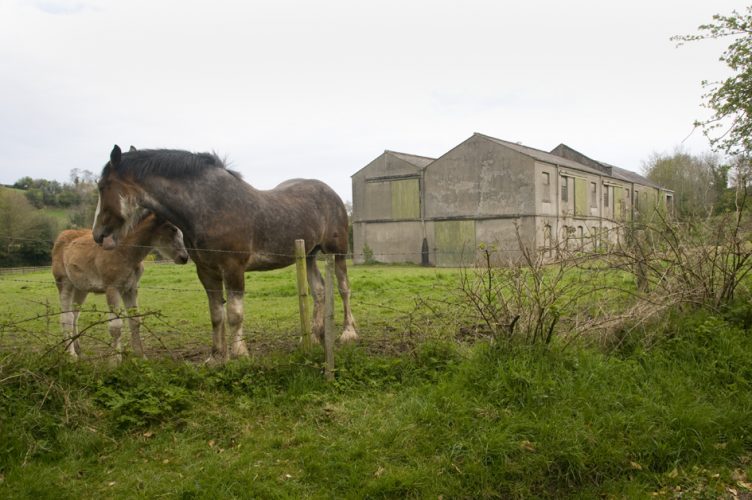Largy Heritage

Introducing Largy
20th March 2019
Join the Largy Archive
20th March 2019Largy Heritage
Ritter’s Generator
This is the only surviving example in Northern Ireland of a hydro-electric power station.
The station was built in 1896 by John Ritter, who installed three water turbines here to generate an alternate current to light his house at Roe Park. The venture was so successful that he later formed the Limavady Electric Company, which supplied electricity to Limavady and Ballykelly.
In 1946 the Dogleap Station was acquired by the Electricity Board for Northern Ireland. It was closed in 1967, when electricity could be generated more cheaply and efficiently with fossil fuels. As we have become aware of the environmental impact of using fossil fuels the possibility of re-opening the hydro-electric power station has been investigated, but has not yet been developed. It remains a memorial to Ritter’s foresight and pioneering spirit.
Largy Bridge
A bridge was first erected here around 1624 by Sir Thomas Phillips, during the Plantation of the area under the direction of the Honourable the Irish Society.
The original bridge collapsed in 1680 and was replaced by a wooden bridge after 1782, and then the present stone bridge in 1828. During the 1840s, the bridge was widened by famine relief workers to become a toll bridge. It has altered little since then and still provides a dramatic focal point for the surrounding buildings and landscape.
Carrick Mills
This large complex of mill buildings housed a wide variety of industrial activity during the nineteenth century.
There was a linen bleaching mill here in the early 1800s. It was converted into a flax scutching mill in the 1830s and later into a corn mill. The complex also included a corn kiln, a flour mill and a flax retting mill, with associated stores and houses. The mills were powered by water wheels up to 11 feet high and a mill race leading from the River Roe at Carrick Rocks.
Largy Primary School
Largy Primary School opened on 1st January 1859 and is the oldest primary school in the Western Education and Library Board. Its imaginative building, almost unchanged since it was built, makes it almost unique.
It was built by the local landlord, Samuel Maxwell Alexander, who chose the site after riding throughout his estate planting flags on every hill top to find which one was the highest. There was one classroom heated by an open fire at each end and connected to an adjoining two storey teacher’s residence.
The Largy Pillars at the school’s entrance were built during improvement works in 1939 and have been a popular meeting place for the local community for generations, partly because they are also the location of the local post box.
In 1962, the school was threatened with closure, but was saved through a determined campaign by the local community and media. However, numbers remained small and in 2008 it closed to merge with Dungiven and Burnfoot Primary Schools at a new site in Burnfoot.
Largy Primary School
Largy Primary School opened on 1st January 1859 and is the oldest primary school in the Western Education and Library Board. Its imaginative building, almost unchanged since it was built, makes it almost unique.
It was built by the local landlord, Samuel Maxwell Alexander, who chose the site after riding throughout his estate planting flags on every hill top to find which one was the highest. There was one classroom heated by an open fire at each end and connected to an adjoining two storey teacher’s residence.
The Largy Pillars at the school’s entrance were built during improvement works in 1939 and have been a popular meeting place for the local community for generations, partly because they are also the location of the local post box.
In 1962, the school was threatened with closure, but was saved through a determined campaign by the local community and media. However, numbers remained small and in 2008 it closed to merge with Dungiven and Burnfoot Primary Schools at a new site in Burnfoot.
The Largy Ploughman Poet
Samuel Connor, known as the Largy Ploughman Poet, was born in this small cottage in 1883 to a large farming family. He wrote ‘Sweet Largy Braes’, a well-known song praising the beauty of the local countryside.
Samuel attended Largy School until he was 12 years old, but he was an enthusiastic reader and soon began to write poetry. His work was very popular, and was regularly published in the Northern Constitution and the Coleraine Chronicle, even after he and his family emigrated to Canada in 1925. He died in Brampton, Ontario on 2nd October 1958, aged 76, but his work is still remembered and often recited.
Ah! When I am doomed among strangers to toil,
The land of my boyhood I cannot revile,
No, oft in my rapture still let me return
To view the dear cottage in which I was born,
There let me roam where sweet friendship delays;
There’s no spot in this world like the sweet Largy Braes.
From ‘Sweet Largy Braes’ written 23rd June 1923

